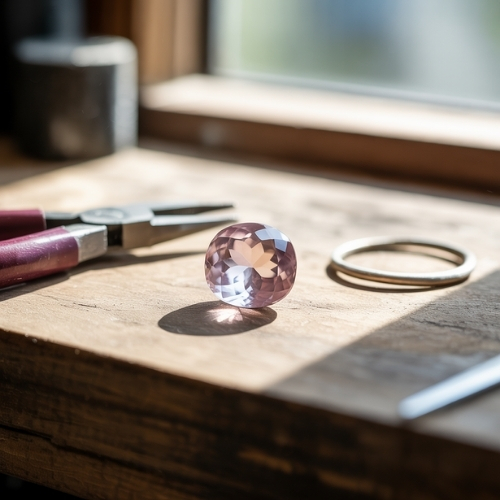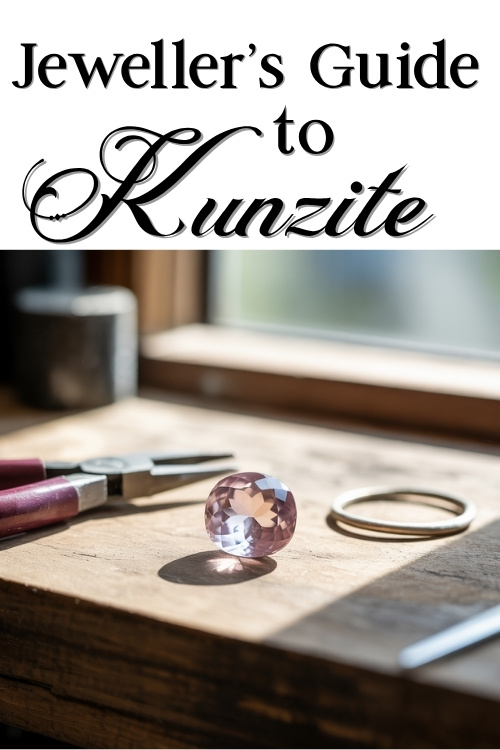Kunzite is the soft-spoken gem of the spodumene family, glowing in gentle pinks and lilac tones that feel almost ethereal. Often compared to a blush in crystal form, it carries a quiet elegance that’s especially compelling in larger cuts. This is a gem for designers drawn to femininit, and a touch of romance, especially when a pastel palette is part of the brief.
While it remains something of a hidden treasure next to more mainstream pink stones, kunzite holds its own with luminous transparency, size availability, and a unique emotional presence.
Basic Identification Information
Name & Synonyms
Kunzite, pink spodumene
Species
Spodumene
Colour Range
Light to medium pink, lilac, and violet-pink
(Some stones may show subtle orangey, purplish, or reddish undertones)
Refractive Index
1.655 – 1.681
Birefringence
0.014 – 0.016
Optical Sign
Biaxial +
Pleochroism
Strong. some stones show 2 colours, others 3.
Pink, purple/violet and near colourless
Specific Gravity
3.15 – 3.21
Fluorescence
Inert to strong
When present, typically orange to violet under longwave UV
Lustre
Vitreous – glass-like
Clarity
Type I
Generally kunzite is eye-clean, but minor inclusions may be visible in larger stones
Gems Often Mistaken For Kunzite
Morganite, pink sapphire, rose quartz, pink tourmaline
Mohs Hardness
6.5 – 7
Wearability
Fair to Good
Birthstone
Not a traditional or modern birthstone
Spotting Synthetic (Lab-Grown) Kunzite
To date, labs have not successfully synthesised spodumene crystals for the gem trade, which means synthetic kunzite doesn’t exist.
Any gem marketed as “lab-grown kunzite” is likely an imitation, often made from synthetic corundum or coloured glass. These simulants mimic the colour but have entirely different physical and optical properties.
Common Treatments
Most kunzite available today is irradiated to enhance or stabilise its pink tones. This treatment is generally stable under normal wear, but prolonged exposure to sunlight or strong UV may cause fading.
Some stones are also heat-treated to deepen or shift colour slightly.
Always assume treatment unless otherwise stated. Untreated kunzite does exist but is uncommon and typically commands a higher price.
Durability & Setting Considerations
Kunzite ranks well on the Mohs scale, but its perfect cleavage in two directions makes it structurally fragile, similar to tanzanite or topaz. One hard knock can cause the gem to split or splinter, especially at corners or along thin edges.
Because of this, kunzite is best suited to pendants, earrings, or occasion rings where physical stress is minimal. For ring designs, aim for protective settings with prongs that cradle the stone securely or bezel styles that shield vulnerable areas.
Always use gentle pressure during setting, and consider pre-notched prongs or custom settings designed for fragile gems.
Care Instructions
Cleaning
Use warm, soapy water and a soft brush. Avoid ultrasonic and steam cleaners due to cleavage risk and potential fading.
Storage
Wrap individually and store away from harder gems like sapphires or spinels. A soft pouch or padded compartment is ideal.
Daily Wear
Kunzite is best reserved for evening wear or special occasions. Avoid prolonged sunlight, excessive heat, or sharp impacts. Recommend care similar to that used for tanzanite or emerald.
Market & Ethical Notes
Kunzite is sourced from regions including Afghanistan, Brazil, Madagascar, and the United States (notably California). It forms in large crystals, allowing for impressive carat sizes at relatively accessible prices, especially compared to pink sapphire.
Ethical sourcing is possible, and reputable dealers often disclose both treatment and origin.
Symbolic & Spiritual Meanings
Kunzite is often associated with emotional healing, gentle love, and heart energy. Thought to promote calm, empathy, and forgiveness, it’s linked to the heart chakra and frequently chosen for its tender, supportive aura.
Some spiritual practitioners use kunzite as a calming companion during grief or personal transition, and it’s sometimes recommended for those needing emotional reassurance.
🔗 Dive deeper into Kunzite’s Symbolic & Spiritual Meanings
Etymology
Kunzite is named after George Frederick Kunz, the renowned American gemmologist who helped introduce it to the Western gem trade in the early 1900s. A passionate gem advocate and author, Kunz wrote The Curious Lore of Precious Stones, my favourite gemstone book.
🔗Curious about how kunzite was viewed in ancient cultures? Explore its fascinating myths and legends (coming soon)
📌 Save this jeweller’s guide to kunzite for quick reference next time you’re working with this stunning gem.


